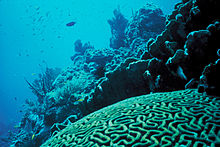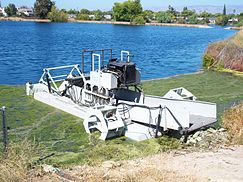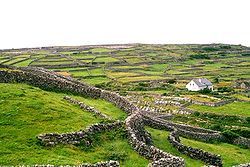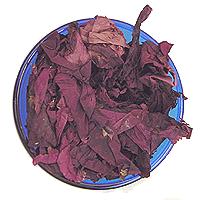
Algae
About this schools Wikipedia selection
SOS Children offer a complete download of this selection for schools for use on schools intranets. Child sponsorship helps children one by one http://www.sponsor-a-child.org.uk/.
| Algae | ||
|---|---|---|
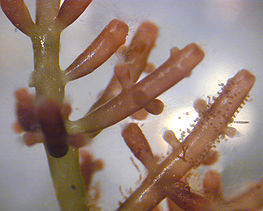 Laurencia, a genus of red algae from Hawaii
|
||
| Scientific classification | ||
|
||
| Included groups | ||
|
||
| Excluded groups | ||
|
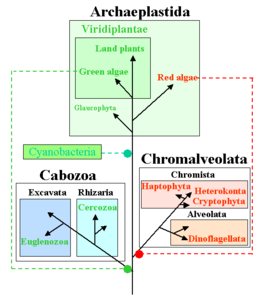
Algae ( / ˈ æ l dʒ iː / or / ˈ æ l ɡ iː /; singular alga / ˈ æ l ɡ ə /, Latin for "seaweed") are a very large and diverse group of simple, typically autotrophic organisms, ranging from unicellular to multicellular forms, such as the giant kelps that grow to 65 meters in length. Most are photosynthetic like plants, and "simple" because they lack the many distinct cell and organ types found in land plants. The largest and most complex marine forms are called seaweeds.
Though the prokaryotic cyanobacteria are informally referred to as blue-green algae, this usage is incorrect since they are regarded as bacteria. The term algae is now restricted to eukaryotic organisms. All true algae therefore have a nucleus enclosed within a membrane and plastids bound in one or more membranes. Algae constitute a polyphyletic group, as they do not include a common ancestor, although their plastids seem to have a single origin. Diatoms are also examples of algae.
Algae exhibit a wide range of reproductive strategies, from simple, asexual cell division to complex forms of sexual reproduction.
Algae lack the various structures that characterize land plants, such as the leaf-like phyllids of bryophytes, rhizoids in nonvascular plants and the roots, leaves and other organs that are found in tracheophytes ( vascular plants). Many are phototrophic, although some groups contain members that are mixotrophic, deriving energy both from photosynthesis and uptake of organic carbon either by osmotrophy, myzotrophy, or phagotrophy. Some unicellular species rely entirely on external energy sources and have limited or no photosynthetic apparatus.
Nearly all algae have photosynthetic machinery ultimately derived from cyanobacteria, and so produce oxygen as a by-product of photosynthesis, unlike other photosynthetic bacteria such as purple and green sulfur bacteria. Fossilized filamentous algae from the Vindhya basin have been dated back to 1.6 to 1.7 billion years ago.
Etymology and study
The singular alga is the Latin word for a particular seaweed and retains that meaning in English. The etymology is obscure. Although some speculate that it is related to Latin algēre, "be cold", there is no known reason to associate seaweed with temperature. A more likely source is alliga, "binding, entwining."
The Ancient Greek word for seaweed was φῦκος (fūkos or phykos), which could mean either the seaweed (probably red algae) or a red dye derived from it. The Latinization, fūcus, meant primarily the cosmetic rouge. The etymology is uncertain, but a strong candidate has long been some word related to the Biblical פוך (pūk), "paint" (if not that word itself), a cosmetic eye-shadow used by the ancient Egyptians and other inhabitants of the eastern Mediterranean. It could be any colour: black, red, green, blue.
Accordingly the modern study of marine and freshwater algae is called either phycology or algology, depending on whether the Greek or Latin root is used. The name Fucus appears in a number of taxa.
Classification
While cyanobacteria have been traditionally considered algae, recent works usually exclude them due to large differences such as the lack of membrane-bound organelles, the presence of a single circular chromosome, the presence of peptidoglycan in the cell walls, and ribosomes different in size and content from those of the Eukaryotes. Rather than in chloroplasts, they conduct photosynthesis on specialized infolded cytoplasmic membranes called thylakoid membranes. Therefore, they differ significantly from algae despite occupying similar ecological niches.
By modern definitions, algae are Eukaryotes and conduct photosynthesis within membrane-bound organelles called chloroplasts. Chloroplasts contain circular DNA and are similar in structure to cyanobacteria, presumably representing reduced cyanobacterial endosymbionts. The exact nature of the chloroplasts is different among separate lineages of algae, reflecting different endosymbiotic events. The table below describes the composition of the three major groups of algae. Their lineage relationships are shown in the figure in the upper right. Many of these groups contain some members that are no longer photosynthetic. Some retain plastids, but not chloroplasts, while others have lost plastids entirely.
Phylogeny based on plastid not nucleocytoplasmic genealogy:
|
|
Cyanobacteria |
|||||||||||||||||||||||||||||||||||||||||||||||||||
|
|
||||||||||||||||||||||||||||||||||||||||||||||||||||
|
|
|
|||||||||||||||||||||||||||||||||||||||||||||||||||
|
|
| Supergroup affiliation | Members | Endosymbiont | Summary |
|---|---|---|---|
| Primoplantae/ Archaeplastida |
|
Cyanobacteria | These algae have primary chloroplasts, i.e. the chloroplasts are surrounded by two membranes and probably developed through a single endosymbiotic event. The chloroplasts of red algae have chlorophylls a and c (often), and phycobilins, while those of green algae have chloroplasts with chlorophyll a and b. Higher plants are pigmented similarly to green algae and probably developed from them, and thus Chlorophyta is a sister taxon to the plants; sometimes they are grouped as Viridiplantae. |
| Excavata and Rhizaria |
|
Green algae |
These groups have green chloroplasts containing chlorophylls a and b. Their chloroplasts are surrounded by four and three membranes, respectively, and were probably retained from ingested green algae. Chlorarachniophytes, which belong to the phylum Cercozoa, contain a small nucleomorph, which is a relict of the algae's nucleus. Euglenids, which belong to the phylum Euglenozoa, live primarily in freshwater and have chloroplasts with only three membranes. It has been suggested that the endosymbiotic green algae were acquired through myzocytosis rather than phagocytosis. |
| Chromista and Alveolata |
|
Red algae |
These groups have chloroplasts containing chlorophylls a and c, and phycobilins.The shape varies from plant to plant. they may be of discoid, plate-like, reticulate, cup-shaped, spiral or ribbon shaped. They have one or more pyrenoids to preserve protein and starch. The latter chlorophyll type is not known from any prokaryotes or primary chloroplasts, but genetic similarities with red algae suggest a relationship there. In the first three of these groups (Chromista), the chloroplast has four membranes, retaining a nucleomorph in Cryptomonads, and they likely share a common pigmented ancestor, although other evidence casts doubt on whether the Heterokonts, Haptophyta, and Cryptomonads are in fact more closely related to each other than to other groups. The typical dinoflagellate chloroplast has three membranes, but there is considerable diversity in chloroplasts within the group, and it appears there were a number of endosymbiotic events. The Apicomplexa, a group of closely related parasites, also have plastids called apicoplasts. Apicoplasts are not photosynthetic but appear to have a common origin with Dinoflagellate chloroplasts. |
W.H.Harvey (1811—1866) was the first to divide algae into four divisions based on their pigmentation. This is the first use of a biochemical criterion in plant systematics. Harvey's four divisions are: red algae (Rhodophyta), brown algae (Heteromontophyta), green algae (Chlorophyta) and Diatomaceae.
Relationship to higher plants
The first plants on earth probably evolved from shallow freshwater algae much like Chara some 400 million years ago. These probably had an isomorphic alternation of generations and were probably filamentous. Fossils of isolated land plant spores suggest land plants may have been around as long as 475 million years ago.
Morphology
A range of algal morphologies are exhibited, and convergence of features in unrelated groups is common. The only groups to exhibit three dimensional multicellular thalli are the reds and browns, and some chlorophytes. Apical growth is constrained to subsets of these groups: the florideophyte reds, various browns, and the charophytes. The form of charophytes is quite different to those of reds and browns, because have distinct nodes, separated by internode 'stems'; whorls of branches reminiscent of the horsetails occur at the nodes. Conceptacles are another polyphyletic trait; they appear in the coralline algae and the Hildenbrandiales, as well as the browns.
Most of the simpler algae are unicellular flagellates or amoeboids, but colonial and non-motile forms have developed independently among several of the groups. Some of the more common organizational levels, more than one of which may occur in the life cycle of a species, are
- Colonial: small, regular groups of motile cells
- Capsoid: individual non-motile cells embedded in mucilage
- Coccoid: individual non-motile cells with cell walls
- Palmelloid: non-motile cells embedded in mucilage
- Filamentous: a string of non-motile cells connected together, sometimes branching
- Parenchymatous: cells forming a thallus with partial differentiation of tissues
In three lines even higher levels of organization have been reached, with full tissue differentiation. These are the brown algae,—some of which may reach 50 m in length ( kelps)—the red algae, and the green algae. The most complex forms are found among the green algae (see Charales and Charophyta), in a lineage that eventually led to the higher land plants. The point where these non-algal plants begin and algae stop is usually taken to be the presence of reproductive organs with protective cell layers, a characteristic not found in the other alga groups.
Physiology
Many algae, particularly members of the characeae, have served as model experimental organisms to understand the mechanisms of the water permeability of membranes, osmoregulation, turgor regulation, salt tolerance, cytoplasmic streaming, and the generation of action potentials.
Symbiotic algae
Some species of algae form symbiotic relationships with other organisms. In these symbioses, the algae supply photosynthates (organic substances) to the host organism providing protection to the algal cells. The host organism derives some or all of its energy requirements from the algae. Examples are as follows.
Lichens
Lichens are defined by the International Association for Lichenology to be "an association of a fungus and a photosynthetic symbiont resulting in a stable vegetative body having a specific structure." The fungi, or mycobionts, are from the Ascomycota with a few from the Basidiomycota. They are not found alone in nature but when they began to associate is not known. One mycobiont associates with the same phycobiont species, rarely two, from the green algae, except that alternatively the mycobiont may associate with the same species of cyanobacteria (hence "photobiont" is the more accurate term). A photobiont may be associated with many specific mycobionts or live independently; accordingly, lichens are named and classified as fungal species. The association is termed a morphogenesis because the lichen has a form and capabilities not possessed by the symbiont species alone (they can be experimentally isolated). It is possible that the photobiont triggers otherwise latent genes in the mycobiont.
Coral reefs
Coral reefs are accumulated from the calcareous exoskeletons of marine invertebrates of the order Scleractinia (stony corals). As animals they metabolize sugar and oxygen to obtain energy for their cell-building processes, including secretion of the exoskeleton, with water and carbon dioxide as byproducts. As the reef is the result of a favorable equilibrium between construction by the corals and destruction by marine erosion, the rate at which metabolism can proceed determines the growth or deterioration of the reef.
Dinoflagellates (algal protists) are often endosymbionts in the cells of marine invertebrates, where they accelerate host-cell metabolism by generating immediately available sugar and oxygen through photosynthesis using incident light and the carbon dioxide produced by the host. Stony corals that are reef-building corals ( hermatypic corals) require endosymbiotic algae from the genus Symbiodinium to be in a healthy condition. The loss of Symbiodinium from the host is known as coral bleaching, a condition which leads to the deterioration of a reef.
Sea sponges
Green algae live close to the surface of some sponges, for example, breadcrumb sponge ( Halichondria panicea). The alga is thus protected from predators; the sponge is provided with oxygen and sugars which can account for 50 to 80% of sponge growth in some species.
Life-cycle
Rhodophyta, Chlorophyta and Heterokontophyta, the three main algal Phyla, have life-cycles which show tremendous variation with considerable complexity. In general there is an asexual phase where the seaweed's cells are diploid, a sexual phase where the cells are haploid followed by fusion of the male and female gametes. Asexual reproduction is advantageous in that it permits efficient population increases, but less variation is possible. Sexual reproduction allows more variation, but is more costly. Often there is no strict alternation between the sporophyte and also because there is often an asexual phase, which could include the fragmentation of the thallus.
Numbers

The Algal Collection of the US National Herbarium (located in the National Museum of Natural History) consists of approximately 320,500 dried specimens, which, although not exhaustive (no exhaustive collection exists), gives an idea of the order of magnitude of the number of algal species (that number remains unknown). Estimates vary widely. For example, according to one standard textbook, in the British Isles the UK Biodiversity Steering Group Report estimated there to be 20000 algal species in the UK. Another checklist reports only about 5000 species. Regarding the difference of about 15000 species, the text concludes: "It will require many detailed field surveys before it is possible to provide a reliable estimate of the total number of species ..."
Regional and group estimates have been made as well:
- 5000–5500 species of red algae worldwide
- "some 1300 in Australian Seas"
- 400 seaweed species for the western coastline of South Africa, and 212 species from the coast of KwaZulu-Natal. Some of these are duplicates as the range extends across both coasts, and the total recorded is probably about 500 species. Most of these are listed in List of seaweeds of South Africa. These exclude phytoplankton and crustose corallines.
- 669 marine species from California (US)
- 642 in the check-list of Britain and Ireland
and so on, but lacking any scientific basis or reliable sources, these numbers have no more credibility than the British ones mentioned above. Most estimates also omit microscopic algae, such as phytoplankton.
The most recent estimate suggests a total number of 72,500 algal species worldwide.
Distribution
The topic of distribution of algal species has been fairly well studied since the founding of phytogeography in the mid-19th century AD. Algae spread mainly by the dispersal of spores analogously to the dispersal of Plantae by seeds and spores. Spores are everywhere in all parts of the Earth: the waters fresh and marine, the atmosphere, free-floating and in precipitation or mixed with dust, the humus and in other organisms, such as humans. Whether a spore is to grow into an organism depends on the combination of the species and the environmental conditions of where the spore lands.
The spores of fresh-water algae are dispersed mainly by running water and wind, as well as by living carriers. The bodies of water into which they are transported are chemically selective. Marine spores are spread by currents. Ocean water is temperature selective, resulting in phytogeographic zones, regions and provinces.
To some degree the distribution of algae is subject to floristic discontinuities caused by geographical features, such as Antarctica, long distances of ocean or general land masses. It is therefore possible to identify species occurring by locality, such as "Pacific Algae" or "North Sea Algae". When they occur out of their localities, it is usually possible to hypothesize a transport mechanism, such as the hulls of ships. For example, Ulva reticulata and Ulva fasciata travelled from the mainland to Hawaii in this manner.
Mapping is possible for select species only: "there are many valid examples of confined distribution patterns." For example, Clathromorphum is an arctic genus and is not mapped far south of there. On the other hand, scientists regard the overall data as insufficient due to the "difficulties of undertaking such studies."
Locations
Algae are prominent in bodies of water, common in terrestrial environments and are found in unusual environments, such as on snow and on ice. Seaweeds grow mostly in shallow marine waters, under 100 metres (330 ft); however some have been recorded to a depth of 360 metres (1,180 ft).
The various sorts of algae play significant roles in aquatic ecology. Microscopic forms that live suspended in the water column ( phytoplankton) provide the food base for most marine food chains. In very high densities ( algal blooms) these algae may discolor the water and outcompete, poison, or asphyxiate other life forms.
Algae are variously sensitive to different factors, which has made them useful as biological indicators in the Ballantine Scale and its modification.
Uses
Agar
Agar, a gelatinous substance derived from red algae, has a number of commercial uses. It is a good medium for bacteria.
Alginates
Between 100,000 and 170,000 wet tons of Macrocystis are harvested annually in California for alginate extraction and abalone feed.
Fertilizer
For centuries seaweed has been used as a fertilizer; George Owen of Henllys writing in the 16th century referring to drift weed in South Wales:
This kind of ore they often gather and lay on great heapes, where it heteth and rotteth, and will have a strong and loathsome smell; when being so rotten they cast on the land, as they do their muck, and thereof springeth good corn, especially barley ... After spring-tydes or great rigs of the sea, they fetch it in sacks on horse backes, and carie the same three, four, or five miles, and cast it on the lande, which doth very much better the ground for corn and grass.
Today, algae are used by humans in many ways; for example, as fertilizers, soil conditioners and livestock feed. Aquatic and microscopic species are cultured in clear tanks or ponds and are either harvested or used to treat effluents pumped through the ponds. Algaculture on a large scale is an important type of aquaculture in some places. Maerl is commonly used as a soil conditioner.
Nutrition
Naturally growing seaweeds are an important source of food, especially in Asia. They provide many vitamins including: A, B1, B2, B6, niacin and C, and are rich in iodine, potassium, iron, magnesium and calcium. In addition commercially cultivated microalgae, including both algae and cyanobacteria, are marketed as nutritional supplements, such as Spirulina, Chlorella and the Vitamin-C supplement, Dunaliella, high in beta-carotene.
Algae are national foods of many nations: China consumes more than 70 species, including fat choy, a cyanobacterium considered a vegetable; Japan, over 20 species; Ireland, dulse; Chile, cochayuyo. Laver is used to make "laver bread" in Wales where it is known as bara lawr; in Korea, gim; in Japan, nori and aonori. It is also used along the west coast of North America from California to British Columbia, in Hawaii and by the Māori of New Zealand. Sea lettuce and badderlocks are a salad ingredient in Scotland, Ireland, Greenland and Iceland.
The oils from some algae have high levels of unsaturated fatty acids. For example, Parietochloris incisa is very high in arachidonic acid, where it reaches up to 47% of the triglyceride pool. Some varieties of algae favored by vegetarianism and veganism contain the long-chain, essential omega-3 fatty acids, Docosahexaenoic acid (DHA) and Eicosapentaenoic acid (EPA). Fish oil contains the omega-3 fatty acids, but the original source is algae ( microalgae in particular), which are eaten by marine life such as copepods and are passed up the food chain. Algae has emerged in recent years as a popular source of omega-3 fatty acids for vegetarians who cannot get long-chain EPA and DHA from other vegetarian sources such as flaxseed oil, which only contains the short-chain Alpha-Linolenic acid (ALA).
Pollution control
- Sewage can be treated with algae, reducing the need for greater amounts of toxic chemicals than are already used.
- Algae can be used to capture fertilizers in runoff from farms. When subsequently harvested, the enriched algae itself can be used as fertilizer.
- Aquariums and ponds can be filtered using algae, which absorb nutrients from the water in a device called an algae scrubber, also known as an "ATS".
Agricultural Research Service scientists found that 60-90% of nitrogen runoff and 70-100% of phosphorus runoff can be captured from manure effluents using an algal turf scrubber (ATS). Scientists developed the ATS, which are shallow, 100-foot raceways of nylon netting where algae colonies can form, and studied its efficacy for three years. They found that algae can readily be used to reduce the nutrient runoff from agricultural fields and increase the quality of water flowing into rivers, streams, and oceans. The enriched algae itself also can be used as a fertilizer. Researchers collected and dried the nutrient-rich algae from the ATS and studied its potential as an organic fertilizer. They found that cucumber and corn seedlings grew just as well using ATS organic fertilizer as they did with commercial fertilizers.
Pigments
The natural pigments produced by algae can be used as an alternative to chemical dyes and coloring agents.
Stabilizing substances
Carrageenan, from the red alga Chondrus crispus, is used as a stabilizer in milk products.





